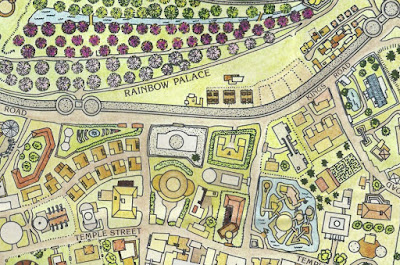 |
| Cartography by Geoff Valley & Curtis Smith |
In a recent post, I had occasion to reference the Lankhmar™: City of Adventure sourcebook, published by TSR thirty years ago. Of interest to me are the rule changes made to bring standard first edition Dungeon & Dragons more in line with the milieu of Fritz Leiber's setting.
In Deities & Demigods™, the gods of Nehwon are treated like other gods; they are listed with movement rates, hit points, experience levels, and other attributes which seem incongruous with the nature of deities. In the Lankhmar sourcebook, gods are treated as abstract entities. Gods have a Cultural Rank, Area of Influence, Worshippers Alignment, and Symbol. However, there are two instances where gods have “physical manifestations” and additional, appropriate information (Number of Attacks, Size, etc.) is provided for encounters with player characters.
Note that a god doesn't have an alignment, but the alignment of the god's followers is specified. 'Area of Influence' refers to the geographical area of Nehwon where a god exerts power. (These areas can overlap.) 'Cultural Rank' is the “power” of a god relative to other gods (within the context of the city of Lankhmar).
Characters of mortal disposition – including player characters – have Social Levels, which “generally represent how important an individual is regarded by others in [Lankhmar].” The Overlord of Lankhmar has a Social Level of 15, the highest level possible. According to page 74, “A Player Character's Social Level is equal to 1/3 his level of experience, with a maximum of 10.” Some situations are listed which can modify Social Level. For instance, spending “at least twice as much money as folk of the equivalent [Social Level]” raises Social Level by one; a public display of cowardice reduces Social Level by one.
Non-player characters who do not have a character class “have a social level established by their profession and their level of accomplishment within the profession.” The descriptions of the various guilds indicate the minimum Social Levels of guild personnel. For instance, with regard to the Moneylenders' Guild, an apprentice has a minimum Social Level of 2; a journeyman, a level of 3; a master, 5; and an official, 6.
Social Level affects the results of encounters. When using the Encounter Reaction table of the Dungeon Masters Guide (p. 63), “Each level of difference [between the PC and the encountered NPC] gives a 5% modifier (up or down, as appropriate) to the encounter reaction dice roll.” Also...
When a PC encounters members of the city guard that would otherwise accost the character, there is a 10% chance per Social Level of the character (except for level 1) that the guards will ignore the character and go on about their business. Thus, a character of SL 4 has a 30% chance of avoiding a guard encounter.The characters of Fafhrd and the Gray Mouser “must spend twice as much to maintain the same social level as normal inhabitants of Lankhmar...[and] twice as much to attain the next social level compared to most Lankhmarians.” Unfortunately, no table is supplied that indicates the amount of money a person of any given Social Level spends to maintain that level or advance to the next higher level.
Also, Fafhrd and the Gray Mouser are “susceptible to the charms of beautiful women.” If Fafhrd and the Gray Mouser are being used as player characters and they do not “act as if charmed in the presence of a woman with a [high] Charisma,” their Social Level can be reduced. For Charisma 18, the loss is 1 – 6; for Charisma 16 or 17, there is a 50% chance of losing 1 – 6 Social Levels.
It seems reasonable that a couple of adventurers would need to spend more money than 'normal' people in order to attain and maintain social status; 'normal' people are embedded in the community while adventurers have a tenuous connection. Yet a reduction of Social Level for failure to succumb to feminine wiles seems a bit forced. The 'susceptibility' of the Mouser and Fafhrd is a matter of role-playing. Should good role-playing be rewarded or should lack of role-playing be penalized? (Or both?) I am inclined to offer a carrot rather than brandish a stick; however, in this case we are dealing with established characters with a distinct idiom. As such, it may be appropriate to impose a penalty when that idiom is not respected. Still, in my estimation, Social Level is an unfitting target of that penalty; a reduction in experience points is more suitable. Does that sound too severe? Either embrace the role or play an original character.
I DM Lankhmar frequently and I have always used Fharfrd and the Mouser as NPCs for the very reason you bring up.
ReplyDelete